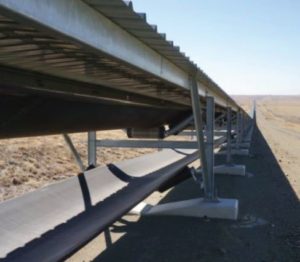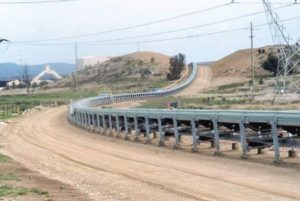 A 16.6-mile-long covered conveyor belt system would bring sand for hydraulic fracturing from West Texas into Southeast New Mexico, according to a development plan written by OLC Kermit, LLC, a subsidiary of Atlas Sand Company, LLC. The plan was submitted in January to the Bureau of Land Management (BLM) Carlsbad Field Office as part of an application for a right of way (ROW) on federal land.
A 16.6-mile-long covered conveyor belt system would bring sand for hydraulic fracturing from West Texas into Southeast New Mexico, according to a development plan written by OLC Kermit, LLC, a subsidiary of Atlas Sand Company, LLC. The plan was submitted in January to the Bureau of Land Management (BLM) Carlsbad Field Office as part of an application for a right of way (ROW) on federal land.
As of press time, the public scoping process had opened and closed, and the BLM was preparing an environmental assessment for the project, known as the Kermit Overland Conveyor Project, said Allison Sandoval, public affairs specialist for the BLM New Mexico State Office.
The BLM is “analyzing a range of alternatives and its associated environmental effects,” Sandoval reported, “and estimates the project’s environmental assessment will be at its draft stage between the months of March and May.” Once the Draft Environmental Assessment is complete, it will undergo a 30-day public comment period. The public will be informed of the comment period via a news release as well as a letter sent out to the BLM’s mailing list, which includes individuals who have identified themselves as interested parties.
Atlas Sand is “keeping public comment on our project to a minimum,” according to a company representative in late February. “However, we will be offering more soon,” he said in an email response to an inquiry made by Permian Basin Oil and Gas Magazine.
As of press time, Atlas Sand had not provided commentary on the project in a public format. However, a full project overview was presented in a 60-plus page document submitted to the New Mexico BLM titled “PLAN OF DEVELOPMENT FOR OLC KERMIT, LLC’S PROPOSED KERMIT OVERLAND CONVEYOR PROJECT, LEA COUNTY, NEW MEXICO.” Atlas Sand was required to complete an Application for Transportation and Utility Systems and Facilities on Federal Lands for a ROW needed to construct, operate, and maintain the conveyer belt system.
According to the submitted project overview, OLC proposes to construct the conveyer belt, approximately 16.6 miles long, to connect a 60-acre offloading facility in Loving County, Texas, to a proposed 140-acre offloading facility in Lea County, New Mexico. The objective is to transport untreated sand to be used in hydraulic fracturing operations.
One of the benefits of the project, according to the OLC proposal, is the expected reduction in the number of miles driven by sand hauling trucks on public roadways each year by approximately 25 million miles, or 47 percent.
The project would require a permanent 70-foot-wide ROW that would cross approximately 16.4 miles of BLM-managed land and 0.2 miles of privately owned land in New Mexico.
The proposed project would utilize existing roads wherever possible to access the ROW. Some existing lease roads would be upgraded to accommodate subsurface crossings of the overland conveyor. A patrol road would parallel the entire conveyor system within the 70-foot-wide ROW corridor.
According to the development plan, the Lea County Offloading Facility would encompass 140 acres where sand would be offloaded from the overland conveyor to storage and truck loading areas. The conveyor belt would offload sand directly into two separate sand storage pile buildings. The sand would then be transferred to truck loading lanes where semitrucks would load sand and then deliver it to oil and gas development areas in the Permian Basin. Plans call for 24 truck loading lanes. In addition, there would be two maintenance and warehouse buildings and two offices located on the northeastern portion of the offloading facility.
Environmental protection measures would include a cover over the conveyer belt to decrease the potential for noise generation and would limit noise to 65-70 decibels within a 1-meter (3.3 feet) distance above ambient levels throughout the majority of the conveyor belt system.
Prior to construction, environmental awareness training would be conducted to instruct personnel on the protection of cultural, ecological, and other natural resources including 1) federal and state laws regarding antiquities and plants and wildlife, including collection and removal; 2) the importance of these resources; and 3) the purpose and necessity of protecting them.
To be added to the BLM’s mailing list, contact Tessa Cisneros from the Carlsbad Field Office at 575-234-5980. For additional information, visit https://go.usa.gov/xpyxw.
_________________________________________________________________________________________________
Julie Anderson, based in Amarillo, is editor of County Progress Magazine, and is known to many readers of PB Oil and Gas Magazine as the prior editor of this publication.










